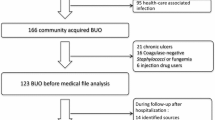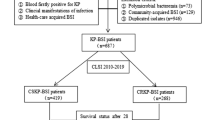Abstract
Despite a significant increase of bloodstream infection caused by extended-spectrum-β-lactamase (ESBL)-producing Enterobacteriaceae in the community-setting, information regarding clinical outcomes of inappropriate empiric therapy (IAT) in patients with those infections is limited. A multicenter-retrospective cohort study was conducted in four hospitals. A total of 249 adults were identified to have community-onset bacteremia caused by ESBL-producing Escherichia coli and Klebsiella pneumoniae, and definitively treated with carbapenems. According to the appropriateness of empiric therapy, individuals were divided into an appropriate empiric therapy (AT) group (n = 106) and IAT group (n = 143). Patients who received AT showed more severe underlying conditions including underlying solid cancer, healthcare-association and intensive care unit (ICU) care, compared to the IAT group. Primary bacteremia was more commonly found in the AT group than in the IAT group, while urinary tract infection predominated more frequently in the IAT group than in the AT group. Multivariate analysis using propensity score analysis indicated that inappropriateness of empiric therapy was not an independent risk factor for 30-day death. ICU care, respiratory tract infection and underlying liver, renal and connective tissue diseases were significantly associated with mortality. In patients with bloodstream infections caused by ESBL-producing E. coli and K. pneumoniae in the community-setting, delay in appropriate therapy was not associated with an increased rate of death if the patients were definitively treated with carbapenems.
Similar content being viewed by others
References
Kang CI, Cha MK, Kim SH, Ko KS, Wi YM, Chung DR, Peck KR, Lee NY, Song JH (2013) Clinical and molecular epidemiology of community-onset bacteremia caused by extended-spectrum beta-lactamase-producing Escherichia coli over a 6-year period. J Korean Med Sci 28(7):998–1004
Guh AY, Bulens SN, Mu Y, Jacob JT, Reno J, Scott J, Wilson LE, Vaeth E, Lynfield R, Shaw KM, Vagnone PM, Bamberg WM, Janelle SJ, Dumyati G, Concannon C, Beldavs Z, Cunningham M, Cassidy PM, Phipps EC, Kenslow N, Travis T, Lonsway D, Rasheed JK, Limbago BM, Kallen AJ (2015) Epidemiology of Carbapenem-resistant Enterobacteriaceae in 7 US communities, 2012-2013. JAMA 314(14):1479–1487
Kang CI, Kim SH, Park WB, Lee KD, Kim HB, Kim EC, Oh MD, Choe KW (2004) Bloodstream infections due to extended-spectrum beta-lactamase-producing Escherichia coli and Klebsiella pneumoniae: risk factors for mortality and treatment outcome, with special emphasis on antimicrobial therapy. Antimicrob Agents Chemother 48(12):4574–4581
Tumbarello M, Sanguinetti M, Montuori E, Trecarichi EM, Posteraro B, Fiori B, Citton R, D’Inzeo T, Fadda G, Cauda R, Spanu T (2007) Predictors of mortality in patients with bloodstream infections caused by extended-spectrum-beta-lactamase-producing Enterobacteriaceae: importance of inadequate initial antimicrobial treatment. Antimicrob Agents Chemother 51(6):1987–1994
Tumbarello M, Sali M, Trecarichi EM, Leone F, Rossi M, Fiori B, De Pascale G, D’Inzeo T, Sanguinetti M, Fadda G, Cauda R, Spanu T (2008) Bloodstream infections caused by extended-spectrum-beta-lactamase- producing Escherichia coli: risk factors for inadequate initial antimicrobial therapy. Antimicrob Agents Chemother 52(9):3244–3252
De Rosa FG, Pagani N, Fossati L, Raviolo S, Cometto C, Cavallerio P, Parlato C, Guglielmi E, Serra R, Di Perri G (2011) The effect of inappropriate therapy on bacteremia by ESBL-producing bacteria. Infection 39(6):555–561
Frakking FN, Rottier WC, Dorigo-Zetsma JW, van Hattem JM, van Hees BC, Kluytmans JA, Lutgens SP, Prins JM, Thijsen SF, Verbon A, Vlaminckx BJ, Cohen Stuart JW, Leverstein-van Hall MA, Bonten MJ (2013) Appropriateness of empirical treatment and outcome in bacteremia caused by extended-spectrum-beta-lactamase-producing bacteria. Antimicrob Agents Chemother 57(7):3092–3099
Kang CI, Wi YM, Ko KS, Chung DR, Peck KR, Lee NY, Song JH (2013) Outcomes and risk factors for mortality in community-onset bacteremia caused by extended-spectrum beta-lactamase-producing Escherichia coli, with a special emphasis on antimicrobial therapy. Scand J Infect dis 45(7):519–525
Charlson ME, Pompei P, Ales KL, MacKenzie CR (1987) A new method of classifying prognostic comorbidity in longitudinal studies: development and validation. J Chronic dis 40(5):373–383
Knaus WA, Draper EA, Wagner DP, Zimmerman JE (1985) APACHE II: a severity of disease classification system. Crit Care med 13(10):818–829
Clinical and Laboratory Standards Institue (CLSI) (2014) Performance standards for antimicrobial susceptibility testing: 24th informational supplement CLSI document M100–24. CLSI, Wayne, PA
McDonald JR, Friedman ND, Stout JE, Sexton DJ, Kaye KS (2005) Risk factors for ineffective therapy in patients with bloodstream infection. Arch Intern med 165(3):308–313
Friedman ND, Kaye KS, Stout JE, McGarry SA, Trivette SL, Briggs JP, Lamm W, Clark C, MacFarquhar J, Walton AL, Reller LB, Sexton DJ (2002) Health care-associated bloodstream infections in adults: a reason to change the accepted definition of community-acquired infections. Ann Intern Med 137(10):791–797
Rodriguez-Bano J, Picon E, Gijon P, Hernandez JR, Ruiz M, Pena C, Almela M, Almirante B, Grill F, Colomina J, Gimenez M, Oliver A, Horcajada JP, Navarro G, Coloma A, Pascual A (2010) Community-onset bacteremia due to extended-spectrum beta-lactamase-producing Escherichia coli: risk factors and prognosis. Clin Infect Dis 50(1):40–48
Cheong HS, Ko KS, Kang CI, Chung DR, Peck KR, Song JH (2010) Prevalence of extended-spectrum beta-lactamase among Enterobacteriacae blood isolates with inducible AmpC beta-lactamase. Infect Chemother 42(5):280–284
Nguyen HM, Shier KL, Graber CJ (2014) Determining a clinical framework for use of cefepime and beta-lactam/beta-lactamase inhibitors in the treatment of infections caused by extended-spectrum-beta-lactamase-producing Enterobacteriaceae. J Antimicrob Chemother 69(4):871–880
Dudley MN, Ambrose PG, Bhavnani SM, Craig WA, Ferraro MJ, Jones RN (2013) Background and rationale for revised clinical and laboratory standards institute interpretive criteria (breakpoints) for Enterobacteriaceae and Pseudomonas Aeruginosa: I. Cephalosporins and Aztreonam. Clin Infect Dis 56(9):1301–1309
Gavin PJ, Suseno MT, Thomson RB Jr, Gaydos JM, Pierson CL, Halstead DC, Aslanzadeh J, Brecher S, Rotstein C, Brossette SE, Peterson LR (2006) Clinical correlation of the CLSI susceptibility breakpoint for piperacillin- tazobactam against extended-spectrum-beta-lactamase-producing Escherichia coli and Klebsiella species. Antimicrob Agents Chemother 50(6):2244–2247
Ambrose PG, Bhavnani SM, Jones RN (2003) Pharmacokinetics-pharmacodynamics of cefepime and piperacillin-tazobactam against Escherichia coli and Klebsiella pneumoniae strains producing extended-spectrum beta-lactamases: report from the ARREST program. Antimicrob Agents Chemother 47(5):1643–1646
Tamma PD, Han JH, Rock C, Harris AD, Lautenbach E, Hsu AJ, Avdic E, Cosgrove SE (2015) Carbapenem therapy is associated with improved survival compared with piperacillin-tazobactam for patients with extended-spectrum beta-lactamase bacteremia. Clin Infect Dis 60(9):1319–1325
Vardakas KZ, Tansarli GS, Rafailidis PI, Falagas ME (2012) Carbapenems versus alternative antibiotics for the treatment of bacteraemia due to Enterobacteriaceae producing extended-spectrum beta-lactamases: a systematic review and meta-analysis. J Antimicrob Chemother 67(12):2793–2803
Lautenbach E, Strom BL, Bilker WB, Patel JB, Edelstein PH, Fishman NO (2001) Epidemiological investigation of fluoroquinolone resistance in infections due to extended-spectrum beta-lactamase-producing Escherichia coli and Klebsiella pneumoniae. Clin Infect Dis 33(8):1288–1294
Han JH, Nachamkin I, Zaoutis TE, Coffin SE, Linkin DR, Fishman NO, Weiner MG, Hu B, Tolomeo P, Lautenbach E (2012) Risk factors for gastrointestinal tract colonization with extended-spectrum beta-lactamase (ESBL)-producing Escherichia coli and Klebsiella species in hospitalized patients. Infect Control Hosp Epidemiol 33(12):1242–1245
Kang CI, Song JH, Chung DR, Peck KR, Ko KS, Yeom JS, Ki HK, Son JS, Lee SS, Kim YS, Jung SI, Kim SW, Chang HH, Ryu SY, Kwon KT, Lee H, Moon C, Shin SY (2010) Risk factors and treatment outcomes of community-onset bacteraemia caused by extended-spectrum beta-lactamase-producing Escherichia coli. Int J Antimicrob Agents 36(3):284–287
Author information
Authors and Affiliations
Corresponding author
Ethics declarations
Funding
This study was funded by the National Evidence-based Healthcare Collaborating Agency (NECA; project number NA2015–001).
Conflict of interest
All authors: none to declare.
Ethical approval
The study was approved by the institutional review board in each hospital.
Informed consent
Informed consent was waived.
Rights and permissions
About this article
Cite this article
Joo, EJ., Park, D.A., Lee, N.R. et al. Impact of appropriateness of empiric therapy on outcomes in community-onset bacteremia by extended-spectrum-β-lactamase producing Escherichia coli and Klebisella pneumoniae definitively treated with carbapenems. Eur J Clin Microbiol Infect Dis 36, 2093–2100 (2017). https://doi.org/10.1007/s10096-017-3031-7
Received:
Accepted:
Published:
Issue Date:
DOI: https://doi.org/10.1007/s10096-017-3031-7




